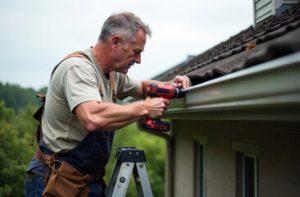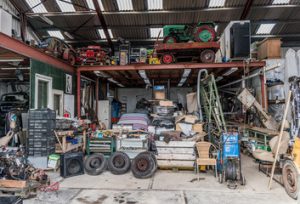Gutters collect rainwater and melting snow, channeling it from your roof into downspouts and away from your home. Without gutters, water could pool over your foundation or damage the siding and fascia boards.

Homes with clogged or nonfunctioning gutters are more likely to experience visual and structural problems, including foundation degradation and basement flooding. New gutters help prevent these issues by properly directing water runoff.
The primary purpose of gutters is to direct water away from the foundation of a building, protecting it from damage caused by moisture buildup and shifting soil. Without gutters or with clogged or improperly functioning ones, rainwater can overflow from the roof and saturate the ground around the home, leading to basement flooding, foundation cracks, and other structural problems. Gutters and downspouts must be properly installed and cleaned frequently of debris like leaves, twigs, bird’s nests, mud and sand, which can block the flow of water and lead to leaks.
In addition, gutters can help reduce erosion on your property by channeling the water away from the foundation of your house, as well as protect painted surfaces and prevent stains by reducing the amount of water exposure. Gutter systems can also stop water leaks in crawl spaces and basements, protect landscaping by preventing washout, and reduce the need for expensive hardscape repairs.
Most homeowners don’t realize how important their gutters are until they experience a problem such as water spilling over the sides or a wet basement. The good news is that proper gutter installation and regular cleaning can help keep your home safe and dry for years to come.
Gutter system components, such as troughs, downspouts and fascia, can be made from materials such as aluminum, galvanized steel, wood, UPVC and concrete. They can be installed in a variety of configurations to accommodate any roofing material and home style. The most common gutter system is made of vinyl, which comes in several colors and styles to match any siding or trim.
When you choose a professional gutter contractor to install or repair your gutters, they will use seamless gutters. Seamless gutters are less prone to leaks and separation due to their continuous design, and they are available in many different colors to complement any home. Gutters and downspouts should be installed with the proper slope to ensure that water drains away from the foundation of your home, preventing saturating the soil and overflowing the gutter system. If your gutters are not properly sloped or positioned, you can purchase downspout extenders to help make sure that the water is draining at least four to eight feet away from your foundation.
Prevents Water Damage
Gutters are a crucial home component that prevent foundation cracks, basement flooding and other costly water damage. Without gutters, rainwater drains right off the roof and collects at the foundation or along the home’s siding, windows and doors. This constant exposure to moisture can cause mold, mildew and rot. Gutters and downspouts help reduce this damage by channeling water away from the house and directing it to areas where it won’t cause harm.
The best way to prevent expensive water damage is to regularly inspect and maintain your gutter system. Make sure your gutters aren’t clogged, and check for signs of wear and tear, like holes, punctures and rust. Promptly repairing any issues with your gutters will keep them in good condition for years to come.
Gutter systems can be constructed of a variety of materials, with each type offering different aesthetics and performance. However, all gutter styles accomplish the same goal of collecting and directing rainwater. Gutter systems also help reduce erosion on your property, minimize paint and stain damage to walls, and stop leaks in crawl spaces and basements.
In addition to preventing structural problems, gutters can also protect your landscaping, preserving the value and beauty of your home’s exterior. Gutters can prevent soil erosion and help your gardens thrive by directing runoff to areas with minimal soil saturation.
Investing in gutters is one of the most important home improvements you can make. Gutters ensure your home is protected from water damage, and they will keep your foundation, foundation, basement, landscaping and the rest of your house in excellent shape for years to come. So if you’re thinking of adding gutters to your home, or you need to have your existing ones replaced, give us a call! We’ll provide you with a free estimate. We can’t wait to hear from you.
Prevents Mold and Mildew Growth
Gutters work to channel rainwater off a roof and into downspouts that direct the water to a designated drainage area, preventing it from pooling near foundation walls. This prevents moisture buildup that could lead to mold and mildew growth, as well as basement flooding. A properly functioning gutter system also ensures that moisture doesn’t seep into crawl spaces or basements, where it can cause serious damage to stored belongings and pose health risks for you and your family.
If gutters are clogged, rainwater may overflow and saturate the surrounding area. This can lead to rotting and deterioration of the shingles, fascia, soffit, and siding on your home. Regular gutter cleaning eliminates this risk and extends the life of your roof.
A clogged gutter creates damp conditions that are perfect for the growth of mold and mildew, which can wreak havoc on your home’s indoor air quality. This is because mildew and mold are known to exacerbate allergies, asthma, and other respiratory problems.
In addition, clogged gutters can encourage mosquitoes and other pests that can infest your home. This is because these pests love the dark, humid environment that is often found in a home with overflowing or clogged gutters. Regular gutter maintenance and a yearly inspection by a professional can reduce the risk of mildew and mold and help keep your family healthy.
Without gutters, rainwater would likely splash onto the side of your house’s exterior walls, which can cause stains and discoloration, wood rot, and peeling paint over time. Gutter systems collect the water from the roof and channel it away, extending the life of your siding and minimizing the need for costly repairs.
Gutters are one of the best tools to protect your property from water damage, especially in Florida’s climate. Heavy rains and humidity can clog your gutters, allowing water to pool on the roof or leak into shingles or underlayment. This can lead to rot, structural issues, and expensive repairs. A clogged gutter can also cause damage to your landscaping, as it can overflow and saturate the soil around the base of your house.
Prevents Damage to Your Landscaping
Gutters are a necessary component of your home’s landscaping, especially if you have delicate flower beds or expansive green lawns. Without gutters, rainwater saturates soil around your house, which can erode the ground over time and cause foundation problems, basement flooding and cracks in your walls. Gutters collect the water and channel it away from your house to avoid these costly issues and protect your landscape.
If your gutters are clogged, the excess water can wash away that second layer of soil, causing soil erosion and ruining your garden. Clogged gutters can also dump large amounts of water in a concentrated area, which washes out the dirt under your plants and can kill them. Gutters help keep your yard healthy by preventing soil erosion, maintaining the proper grading of your lawn and garden areas, preserving your plants, and keeping mud out of your flowers and other shrubbery.
Keeping your gutters clog-free is vital to protecting your landscaping from damage. Leaves, twigs, pine needles, and other debris can collect in your gutters, blocking the flow of rainwater. This clogged water can encourage the growth of fungus and pests, which will ultimately kill your garden and ruin your yard. Gutters that are clogged or damaged cause your rainwater to overflow and create a habitat for pests, which can then enter your house through open windows and other openings. Gutters that are clean and working properly allow your rainwater to easily move through the system and prevent pests from entering your home.
Investing in a good gutter system will save your home from costly repair work. Gutter systems can prevent damage to your foundation, basement, and landscaping, while reducing water exposure that damages the paint and stain on your house siding. Gutters are available in a variety of sizes and materials, including aluminum, vinyl, copper and steel. Choosing the right gutters for your home will depend on your climate and rainfall. A professional roofing, siding, window/door and gutter contractor can help you choose the best system for your property.
